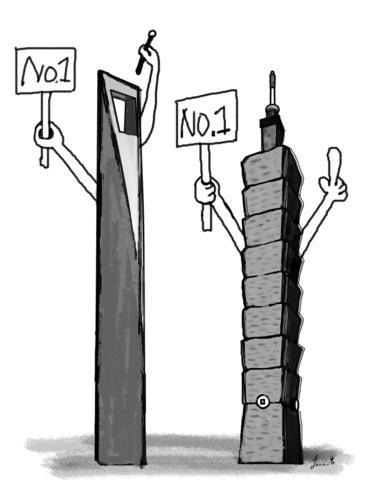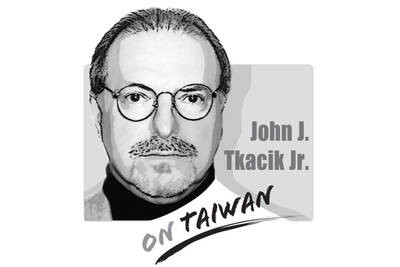When work began on the Shanghai World Financial Center in 1997, in the headiest days of China's economic takeoff, Shanghai was already a city that was hard to impress.
Even then, the erstwhile farmlands of Pudong District boasted two icons: the Oriental Pearl Tower, looking like a science fiction movie prop with its rocket-on-the-launching-pad trunk and glittering, spacestation-like orbs, and the nearby Jin Mao tower, a bejeweled spire of stacked pagodas that boasted the world's highest hotel lobby.
With competition like that, the man behind the project -- one of Japan's foremost real estate developers, Minoru Mori -- knew he had to aim high to make his mark. By the time of the groundbreaking, it seemed as if his team had struck on the right plan.

Mori, who has a Trump-like three dozen or so buildings in Tokyo that bear his name, would offer Shanghai the world's tallest building, at 492m. For extra effect, the roof of his new building would be formed by a giant enclosed circle that would house specially outfitted cars, a sort of Ferris wheel at the top of the world.
If skyscrapers can be said to have journeys, what has happened since has been one long, strange trip indeed. These days, workers are racing to complete the 101-floor building on schedule, mounting skyward floor by floor toward a hitherto unaccustomed view that looks down on the neighboring landmarks.
Big changes
But in truth, neither the schedule nor the building itself bears much resemblance to the original plans, which for many of the people involved must by now seem like a lifetime ago.
Record-breaking skyscrapers have a long and uncanny history of association with economic crisis -- the Empire State Building and Rockefeller Center, for example, were both conceived in the 1920s and completed during the Depression years -- and Mori's gaudy Shanghai dream would be no exception. Within months of the groundbreaking, a financial crash struck Asia, ripping the bottom out of stock markets and real estate markets throughout this region.
Work was halted on the Finance Center, partly out of fears of a shortage of tenants and partly out of doubts over the unspoken premise that lay behind the project: that China's economy was set to lead the world. For five long years, the huge work site sat idle, with nothing reaching skyward save for overgrown grass behind a plain cement wall.
A holding pattern like that would have been enough to sink many developers, but not Mori, for whom completing the project appears to be a point of pride.
"We are not a listed company, so we are able to control our costs very carefully," said Michiho Kishi, a spokesman for the company. "If we had been a listed company, our CEO would have been forced to resign, very simply. That's what makes us unique."
What Mori was unable to control was what happened while his project was frozen.
Five years, it turns out, is an eternity in the record-breaking-skyscraper business, with countries all over Asia throwing their hats into the ring with new structures, each taller than the last.
For Shanghai's would-be title holder, the delay resulted in the building being surpassed even before it could be built, with the additional indignity that the new champion, Taipei 101, a 509m structure, is in the capital of Taiwan.
Design Questions
But that was not the only setback. With anti-Japanese sentiment swelling in China, questions began to be asked about the Shanghai building's design. Some said the large hole at the summit was suspiciously reminiscent of the sun that sits at the center of the Japanese flag. That was a sore point for many Chinese, who still harbor resentment over Japan's military invasion of the country in the 1930s.
Mori's representatives gamely protested that the circle with the sky ride was based on a traditional Chinese symbol, the moon gate, but in the end they quietly backed down, replacing the original design with a squarish slot and ditching the Ferris wheel concept altogether.
But that still left them with the seeming problem that Taipei would have a taller building. Actually, not a problem at all, as visitors to the site soon discover. There they are treated to an extravagant multimedia presentation, complete with mock-ups of the world's tallest buildings.
The Shanghai building is shown standing shoulder to shoulder with its Taiwan rival, barely but perceptibly taller, save for the other building's long antenna. In case this point is lost -- amid a flood of statistics about the building's 91 elevators, or the special weights built into the 90th floor to counteract wind sway, or the 10,000 office people who will eventually work there -- Kishi told a visitor, "Actually if you are counting rooftop height, we are the taller building, but we are not after competition."
While diplomatic, the explanation strains credibility, especially for anyone who knows the history. The Shanghai building was originally designed to have 94 floors, rising to roughly 460m, but has quietly grown since then, with more floors added, as well as more height to each floor, resulting in about 32 extra meters.
But all the one-upmanship will soon be rendered moot by a far heavier hitter that is about to enter the stage: a 701m structure built in Dubai by relatives of Osama bin Laden, which looks likely to hold off the competition for quite a while.

On May 7, 1971, Henry Kissinger planned his first, ultra-secret mission to China and pondered whether it would be better to meet his Chinese interlocutors “in Pakistan where the Pakistanis would tape the meeting — or in China where the Chinese would do the taping.” After a flicker of thought, he decided to have the Chinese do all the tape recording, translating and transcribing. Fortuitously, historians have several thousand pages of verbatim texts of Dr. Kissinger’s negotiations with his Chinese counterparts. Paradoxically, behind the scenes, Chinese stenographers prepared verbatim English language typescripts faster than they could translate and type them
More than 30 years ago when I immigrated to the US, applied for citizenship and took the 100-question civics test, the one part of the naturalization process that left the deepest impression on me was one question on the N-400 form, which asked: “Have you ever been a member of, involved in or in any way associated with any communist or totalitarian party anywhere in the world?” Answering “yes” could lead to the rejection of your application. Some people might try their luck and lie, but if exposed, the consequences could be much worse — a person could be fined,
Xiaomi Corp founder Lei Jun (雷軍) on May 22 made a high-profile announcement, giving online viewers a sneak peek at the company’s first 3-nanometer mobile processor — the Xring O1 chip — and saying it is a breakthrough in China’s chip design history. Although Xiaomi might be capable of designing chips, it lacks the ability to manufacture them. No matter how beautifully planned the blueprints are, if they cannot be mass-produced, they are nothing more than drawings on paper. The truth is that China’s chipmaking efforts are still heavily reliant on the free world — particularly on Taiwan Semiconductor Manufacturing
Last week, Nvidia chief executive officer Jensen Huang (黃仁勳) unveiled the location of Nvidia’s new Taipei headquarters and announced plans to build the world’s first large-scale artificial intelligence (AI) supercomputer in Taiwan. In Taipei, Huang’s announcement was welcomed as a milestone for Taiwan’s tech industry. However, beneath the excitement lies a significant question: Can Taiwan’s electricity infrastructure, especially its renewable energy supply, keep up with growing demand from AI chipmaking? Despite its leadership in digital hardware, Taiwan lags behind in renewable energy adoption. Moreover, the electricity grid is already experiencing supply shortages. As Taiwan’s role in AI manufacturing expands, it is critical that